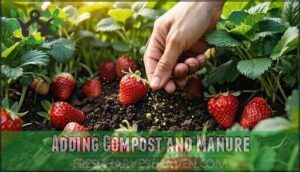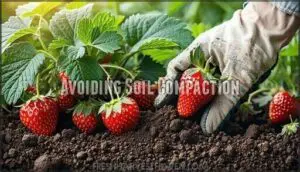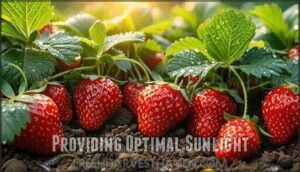This site is supported by our readers. We may earn a commission, at no cost to you, if you purchase through links.
 You’ll want well-draining soil with a pH between 5.5-6.5 for the best soil for growing strawberries.
You’ll want well-draining soil with a pH between 5.5-6.5 for the best soil for growing strawberries.
Sandy loam works perfectly because it drains excess water while holding nutrients your plants crave. Mix in compost or aged manure to boost organic matter – strawberries are hungry little plants that’ll reward you with sweeter berries when fed properly.
Avoid heavy clay that stays soggy, as waterlogged roots spell disaster for your crop. Good drainage isn’t just recommended, it’s essential for preventing root rot and fungal diseases that can wipe out your entire patch.
The right soil mix sets the foundation for those picture-perfect berries you’re dreaming about, and with well-draining soil, sweeter berries, and proper care, you’ll be on your way to a successful harvest, and strawberries will thrive.
Table Of Contents
- Key Takeaways
- Choosing Best Soil
- Types of Strawberries
- Soil Preparation Tips
- 6 Best Soils for Strawberries
- Growing Strawberries Successfully
- Frequently Asked Questions (FAQs)
- What is the best soil mixture for strawberries?
- What brand of potting soil is best for strawberries?
- What do coffee grounds do for strawberry plants?
- What do you fill a strawberry planter with?
- How often should I test my strawberry soil pH?
- Can I reuse last years strawberry potting soil?
- Whats the best fertilization schedule for strawberry plants?
- How deep should I plant strawberry crowns?
- When should I replace my container strawberry soil?
- Conclusion
Key Takeaways
- You’ll need well-draining sandy loam soil with a pH between 5.5-6.5 to prevent root rot and ensure your strawberries absorb nutrients properly.
- You should mix in 1-2 inches of compost or aged manure to boost organic matter, as strawberries are heavy feeders that’ll reward you with sweeter berries when properly nourished.
- You can’t ignore drainage – waterlogged soil causes root rot and fungal diseases that’ll destroy your entire strawberry patch, so avoid heavy clay soils at all costs.
- You’ll get the best results by choosing soil specifically formulated for strawberries like FoxFarm Strawberry Fields or premium organic mixes that provide sustained nutrition for 3-6 months.
Choosing Best Soil
Finding the right soil makes the difference between mediocre berries and a bountiful harvest that’ll have you picking strawberries by the handful.
You’ll need soil that balances drainage with moisture retention while providing the slightly acidic conditions these sweet fruits crave.
Soil PH Level
Getting your soil pH right makes or breaks strawberry success. These sweet berries need slightly acidic conditions, typically between 5.3 and 6.5, to thrive and produce abundant fruit. Most strawberry varieties require slightly acidic soil for ideal growth.
Sweet berries need slightly sour soil – aim for pH 5.3-6.5 for maximum harvest success.
Here’s your pH action plan:
- Test soil pH using digital meters or test strips before planting
- Add lime to raise pH if below 5.3 for better nutrient availability
- Apply sulfur or organic matter to lower pH above 6.5
- Monitor regularly since pH changes affect zinc, iron, and manganese uptake
Organic Matter Importance
Boosting soil organic matter transforms your strawberry patch into a nutrient powerhouse.
Compost benefits include improved water retention and enhanced soil structure, while well-composted manure effects create slow-release nutrition.
You’ll need at least 3% organic matter for ideal growth.
Soil amendments like compost soil additions increase nutrient availability dramatically, supporting stronger plants and sweeter berries.
Addressing replant issues can be achieved through calcium cyanamide treatment, which is a method to enhance soil structure and promote slow-release nutrition.
Drainage and Aeration
You’ll want well-drained soil that doesn’t turn into a soggy mess after watering.
Poor soil drainage spells disaster for strawberry root health, leading to rot and disease.
Container drainage holes are essential, while soil amendments like compost improve soil aeration.
Proper growth depends on well draining soil.
Think of it as creating breathing room for roots to thrive in balanced soil composition.
Types of Strawberries
You’ll need to choose the right strawberry variety for your growing conditions and harvest goals. Each type has different soil requirements and growing patterns that affect your berry production.
June-bearing Strawberries
June-bearing strawberries deliver their treasure in one spectacular burst, typically spanning just 10-21 days in late spring.
These vigorous growth champions produce large, sweet berries perfect for jam-making marathons.
Their early blooming nature means frost can crash the party, so choose your strawberry soil wisely.
Expect serious runner management as these plants spread enthusiastically.
This single harvest approach concentrates all energy into fruit size, making Junebearing varieties ideal when you want maximum berry bounty for preserving.
To maintain quality, consider early morning harvesting for the best results, ensuring you get the most out of your strawberry harvest.
Everbearing Strawberries
Unlike their single-harvest cousins, everbearing strawberries deliver multiple fruiting frequency cycles throughout the season.
These compact plants excel at container growing, producing smaller but sweeter berries in spring and fall harvests. You’ll get moderate yield expectations compared to June-bearers, but the extended season makes up for it.
Their reduced runner production simplifies pruning techniques and maintenance. The best soil for everbearing varieties needs excellent soil drainage and slightly acidic soil pH around 6.0.
Consider using specialized potting mixes for ideal growth. During winter dormancy, these hardy plants rest before resuming their reliable strawberry soil performance.
Day-neutral Strawberries
Day-neutral strawberries offer continuous fruiting throughout the growing season, making them perfect for container growing and extended harvests.
These varieties thrive in moderate climates with well-drained soil and proper nutrients. To guarantee the best growth, consider the specific soil requirements.
Key benefits of day-neutral strawberries:
- Continuous harvests from late spring through fall
- Temperature tolerance between 40-85°F for peak production
- Compact growth with fewer runners, ideal for small spaces
- Quick fruit production within 10 weeks of planting
Soil Preparation Tips
You’ll want to prepare your soil properly before planting to give your strawberries the best start possible.
Adding the right amendments and avoiding common mistakes like soil compaction will set you up for a sweet, abundant harvest.
Adding Compost and Manure
Adding compost and manure transforms ordinary soil into strawberry paradise.
Transform your berry patch with nature’s gold – compost and manure create the foundation for strawberry success.
Apply 1-2 inches of well-aged compost around plants in early spring, avoiding direct crown contact.
Compost benefits include doubled fruit production and enhanced soil microbes.
Choose steer or poultry manure types for maximum nutrient balance.
Fresh manure burns roots, so guarantee six-month composting first to ensure proper application timing and maximize organic matter integration.
Avoiding Soil Compaction
Compacted soil acts like a concrete barrier, blocking root development and preventing your strawberry plants from thriving.
You’ll want to avoid walking on planting beds and work the soil when it’s not too wet or dry. A vital step is ensuring proper soil pH for ideal nutrient availability.
- Test soil readiness: Squeeze a handful – it should crumble, not form a tight ball
- Add organic matter: Mix in compost or aged manure to improve soil structure and aeration
- Use raised beds: They naturally prevent foot traffic while promoting better water infiltration and earthworm activity
6 Best Soils for Strawberries
You’ll want to choose the right soil mix to give your strawberry plants the best start possible.
These six top-rated options provide the perfect balance of drainage, nutrients, and pH levels that strawberries need to produce sweet, juicy berries.
1. Miracle-Gro Organic All Purpose Potting Mix

Consistency matters when you’re hunting for the perfect strawberry soil.
Miracle-Gro’s organic blend delivers reliable nutrition with aged compost and natural fertilizers that feed your plants for up to three months.
You’ll get twice the harvest compared to unfed plants, though the mix drains quickly and requires frequent watering.
The lightweight formula contains perlite for aeration, making it ideal for containers.
Some gardeners report occasional quality inconsistencies between bags, but overall performance remains solid for strawberry cultivation.
Best For: Gardeners seeking a reliable, organic potting mix for container-grown strawberries and other produce.
- Requires frequent watering due to quick-draining formula
- Occasional quality inconsistencies reported between bags
- Higher price per bag compared to some competitors
- Feeds plants for up to three months with aged compost and organic nutrients
- Lightweight, airy blend with perlite offers excellent drainage and root health
- Consistently delivers high yields compared to unfed alternatives
2. FoxFarm Ocean Forest Potting Soil
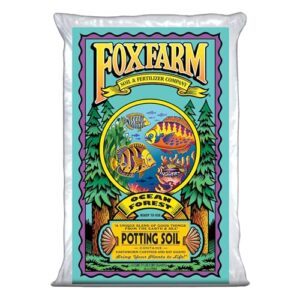
When you’re ready to step up your strawberry game, FoxFarm Ocean Forest delivers premium results. This nutrient-dense blend features composted forest humus, sandy loam, and sphagnum peat moss that creates the perfect foundation for berry production.
You’ll appreciate its balanced pH range of 6.3-6.8, which matches strawberries’ preferences perfectly. The sandy loam provides excellent drainage while the peat moss retains just enough moisture to keep roots happy.
Ideal growth depends on balanced soil pH for nutrient absorption. With earthworm castings, bat guano, and fish emulsion already mixed in, your plants get a nutritional head start that promotes vigorous growth from day one.
Best For: Gardeners who want a premium, nutrient-rich organic soil mix for strawberries, container gardens, and a wide range of plants.
- Contains a balanced blend of organic nutrients like earthworm castings, bat guano, and fish meal for vigorous growth.
- Excellent drainage and moisture retention thanks to sandy loam and sphagnum peat moss.
- Ready to use out of the bag with a pH range perfect for strawberries and many other plants.
- Higher price point than most standard potting mixes.
- High nutrient content may overwhelm sensitive or young plants unless monitored.
- Moisture retention can lead to overwatering issues if not carefully managed.
3. Burpee Organic Potting Soil Mix
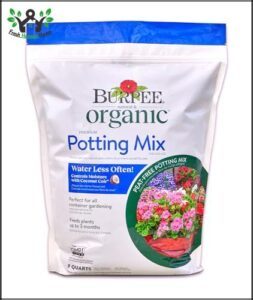
When you’re hunting for an organic solution that won’t break the bank, Burpee Organic Potting Soil Mix delivers impressive results.
This OMRI-listed blend combines coconut coir with slow-release fertilizer, feeding your strawberry plants for up to three months.
The coco coir retains moisture while providing excellent drainage—preventing both drought stress and root rot.
You’ll appreciate the immediate nutrient release for quick establishment, plus the sustainable peat-free formula that’s gentle on the environment and your wallet, offering a slow-release fertilizer.
Best For: Home gardeners looking for an organic, affordable, and easy-to-use potting mix that delivers healthy, high-yield strawberry plants in containers or raised beds.
- Retains moisture and provides excellent drainage with sustainable coconut coir.
- Feeds plants for up to 3 months with organic, slow-release fertilizer.
- OMRI-listed and peat-free, supporting environmentally responsible gardening.
- Slightly dusty and may release spores when opened.
- Some users notice a subtle odor.
- Requires careful handling to avoid spore and dust inhalation.
4. FLORAL Potting Soil for Vegetables Herbs
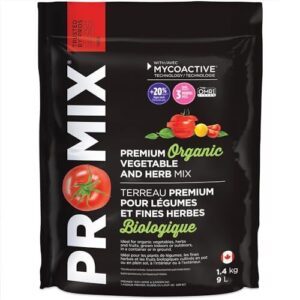
FLORAL’s vegetable and herb potting soil delivers the balanced nutrition your strawberry plants crave.
This blend combines organic compost with perlite for excellent drainage while retaining enough moisture to keep roots happy.
You’ll appreciate how it maintains the slightly acidic pH strawberries prefer without requiring additional amendments.
The organic fertilizer provides sustained feeding for months, eliminating guesswork about nutrient timing.
Plus, it’s designed specifically for edible plants, so you can trust it’s safe for your homegrown berries.
It’s a blend that offers the slightly acidic pH strawberries need to thrive.
Best For: Gardeners looking for a premium organic mix that supports vigorous growth and healthy harvests for vegetables, herbs, and fruits in both containers and garden beds.
- OMRI-listed and fully organic, safe for families and pets
- Contains MYCOACTIVE technology to boost root health and resilience
- Retains moisture well, reducing watering frequency and improving drainage
- Peat-based, though partially offset by added sustainable alternatives
- May require replenishment each season for optimal results
- Pricier than basic garden soil mixes
5. Miracle-Gro Potting Mix 8 qt
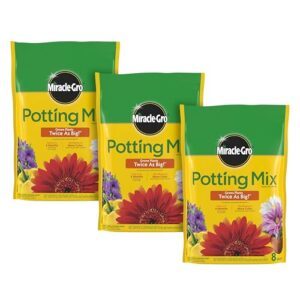
You’ll appreciate this budget-friendly option that doesn’t compromise on quality.
Miracle-Gro’s 8-quart potting mix delivers slow-release nutrients for up to six months, feeding your strawberry plants consistently throughout the growing season.
The formula grows plants twice as big compared to unfed varieties while promoting abundant blooms that translate to more berries.
Each lightweight bag fills two 8-inch containers, making it perfect for patio strawberry gardens.
The mix prevents soil compaction and provides excellent drainage—essential for preventing root rot in strawberries.
Best For: Gardeners seeking a convenient, all-purpose potting mix that promotes fast, healthy growth for strawberries and other container plants.
- Occasional quality issues, such as large sticks or wood pieces in the mix.
- Price and quantity may vary or feel inadequate for larger projects.
- Not an organic mix; contains synthetic fertilizers.
- Feeds plants for up to six months with slow-release nutrients.
- Grows strawberries and other plants up to twice as big versus unfed options.
- Lightweight, easy to use, and provides excellent drainage to prevent root rot.
6. FoxFarm Strawberry Fields Potting Soil

Designed specifically for fruiting plants, FoxFarm Strawberry Fields delivers targeted nutrition with 35-45% coco fiber and phosphorus-rich bat guano.
You’ll get enhanced water retention plus beneficial mycorrhizae that boost nutrient uptake by 50-70%.
However, you’ll need to add 20% perlite for proper drainage since this mix can retain too much moisture.
The earthworm castings and dolomite lime create an ideal pH balance for strawberry production, which is crucial for strawberry production and overall plant health, including the benefits of mycorrhizae.
Best For: Gardeners growing fruiting or flowering plants, especially strawberries and berries, who want an organic, nutrient-rich potting soil for container or raised bed gardening.
- Rich in coco fiber, earthworm castings, and bat guano for strong fruit and flower development.
- Contains mycorrhizae and beneficial bacteria to boost nutrient uptake and root efficiency.
- Maintains proper pH and moisture retention, with a loamy, clean texture free from pests.
- Requires addition of perlite (20%) for proper drainage, especially for succulents or water-sensitive plants.
- Price is higher compared to basic potting mixes and may be a concern for large-scale use.
- Not ideal for seedling establishment or vegetative growth without extra nitrogen supplementation.
Growing Strawberries Successfully
You’ll want to focus on four key areas once you’ve got your strawberry plants in quality soil.
Proper site selection, adequate sunlight, consistent soil care, and pest management will determine whether your strawberries thrive or just survive.
Planting Site Selection
Finding the perfect spot for your strawberry plants requires careful planning beyond just choosing the best soil for strawberries.
Your planting site needs proper sunlight exposure, accessible water access, and adequate space requirements for healthy growth.
Before finalizing your location, conduct soil testing to confirm pH levels and drainage capabilities.
Consider wind protection from strong gusts that can damage delicate plants.
Proper soil preparation starts with selecting a level area where your strawberry soil won’t become waterlogged after heavy rains.
Providing Optimal Sunlight
Your strawberries need at least eight hours of direct sunlight daily for ideal growth and fruit production.
Position plants where morning sun hits first, as this helps dry dew and prevents fungal issues.
While strawberry soil requirements include proper drainage and pH levels, sunlight duration directly affects berry sweetness and yield.
For maximum fruit production, consider that strawberries in containers need consistent moisture levels.
Avoid areas with afternoon shading effects from trees or structures, which reduce light intensity and compromise harvests, to ensure optimal growth.
Maintaining Soil Quality
Your strawberry plants need consistent soil care to keep producing sweet fruit.
Regular soil testing helps you track soil pH and nutrient levels throughout the growing season.
Add compost or organic matter in spring for nutrient replenishment and soil moisture retention.
Time your amendments carefully – avoid heavy fertilizing during fruit development.
Mulching provides erosion control while supporting long-term health of your soil’s structure and drainage improvement.
Controlling Weeds and Pests
Effective pest management keeps your strawberry patch thriving.
Healthy soil creates natural pest resistance while proper weed control protects your plants from nutrient competition.
Here’s your action plan:
- Apply organic pesticides like neem oil for targeted pest control
- Install weed barriers or mulching to suppress weeds and maintain soil moisture
- Practice companion planting with marigolds to deter harmful insects
- Encourage natural predators through beneficial habitat creation
Regular pest identification helps you catch problems early, while maintaining proper soil temperature through mulching creates conditions that favor your strawberries over weeds.
Frequently Asked Questions (FAQs)
What is the best soil mixture for strawberries?
Think of soil as your strawberry plant’s foundation—it’s everything.
You’ll want sandy loam with 5-8 pH, mixed with compost for drainage and nutrients.
This combination prevents waterlogging while retaining moisture your berries crave.
What brand of potting soil is best for strawberries?
FoxFarm Strawberry Fields stands out as the top choice, specifically formulated for strawberries with enhanced phosphorus content and beneficial mycorrhizae fungi for ideal growth.
What do coffee grounds do for strawberry plants?
Like scattered breadcrumbs feeding hungry soil, coffee grounds enhance your strawberry plants’ structure while potentially deterring slugs and snails from munching on your precious berries.
What do you fill a strawberry planter with?
Fill your strawberry planter with a well-draining potting mix combined with compost for nutrients.
You’ll want two-thirds quality potting soil mixed with one-third compost, aged manure, or perlite for proper drainage and healthy growth, ensuring the mix supports healthy growth.
How often should I test my strawberry soil pH?
Test your strawberry soil pH annually in early spring before planting season. If you’re experiencing plant health issues or using amendments, check it twice yearly for ideal growing conditions.
Can I reuse last years strawberry potting soil?
Don’t throw the baby out with the bathwater – you can absolutely refresh last year’s potting soil for strawberries.
Simply mix in fresh compost, test pH levels, and add slow-release fertilizer to replenish nutrients that plants absorbed during the previous growing season, which helps to refresh the soil for the next growing cycle with slow-release fertilizer.
Whats the best fertilization schedule for strawberry plants?
Fertilize strawberries three times yearly: early spring with balanced fertilizer, mid-summer after harvest with low-nitrogen blend, and fall with phosphorus-rich formula to strengthen roots for winter survival.
How deep should I plant strawberry crowns?
Picture your strawberry crown drowning in soil—that’s plant murder.
You’ll want to plant the crown at soil level, keeping it exposed while covering all roots completely underneath.
This prevents crown rot while ensuring proper root establishment.
When should I replace my container strawberry soil?
Replace container strawberry soil every 2-3 years when you notice poor drainage, compacted texture, or declining plant health. Fresh soil restores nutrients and prevents disease buildup that accumulates over time.
Conclusion
Growing strawberries with nutrient-rich conditions transforms ordinary backyard gardening into a rewarding adventure.
You’ll discover that selecting the best soil for growing strawberries makes all the difference between mediocre harvests and abundant, sweet berries.
Remember that proper drainage prevents root problems while organic matter feeds your plants throughout the growing season.
With the right soil foundation, you’ll enjoy consistent harvests year after year, watching your strawberry patch flourish into a productive garden centerpiece that delivers the sweet rewards you’ve been hoping for.
- https://www.instagram.com/highcountryfarmhouse
- https://litefarm.blogspot.com/2018/10/benefits-of-eggshells-for-strawberry-in-backyard-garden.html
- https://www.haifa-group.com/crop-guide/vegetables/strawberry-fertilizer/crop-guide-strawberry-1
- https://strawberries.ces.ncsu.edu/strawberries-plasticulture-considerations-soil/
- https://www.yara.co.uk/crop-nutrition/strawberries/soil-and-water-management/


